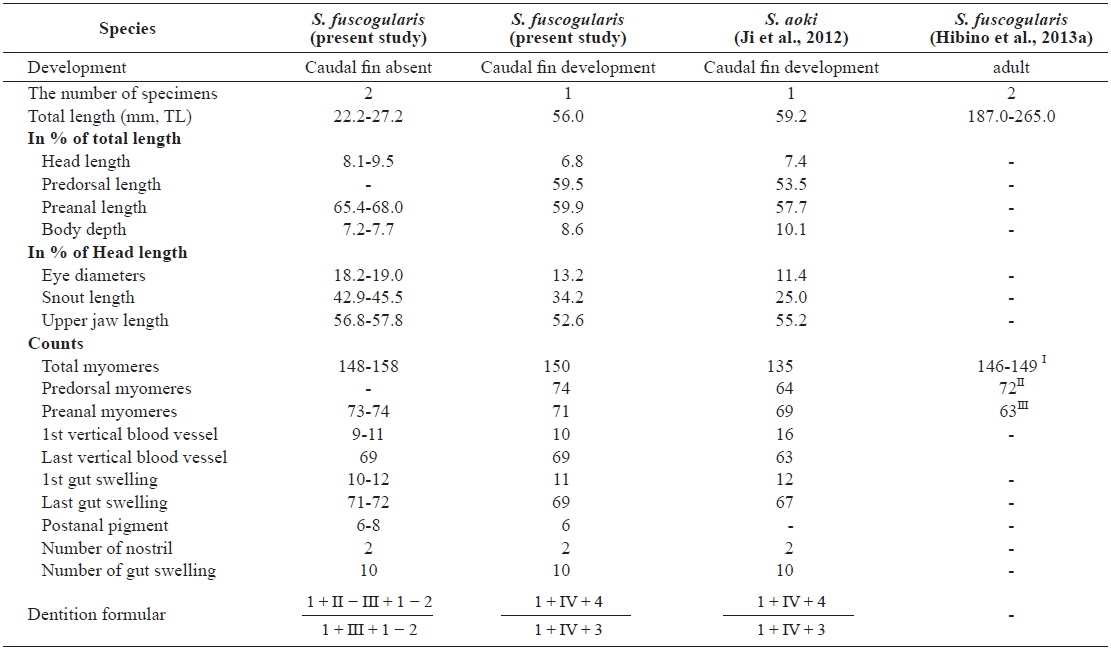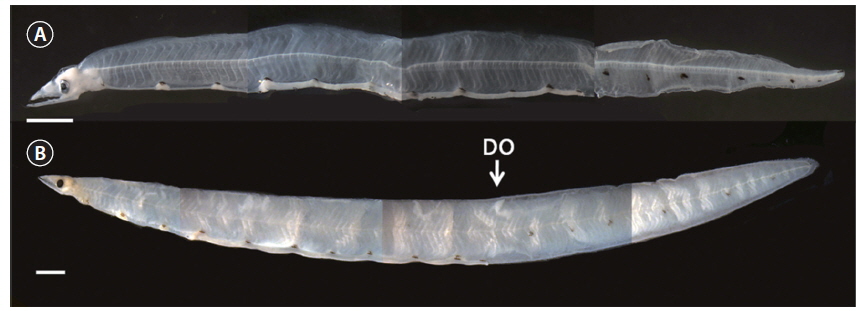



The genus
During November 2009 and October 2010, three leptocephali collected from the East/Japan Sea, and were identified as
Material examined : PKU 5999-6000, 2 specimens, 22.2 mm and 27.2 mm in total length (TL), southern part of the East/Japan Sea (35°40′43″N, 129°44′47″E), October 2010, RN80 net, collected by JK Kim and HS Ji. PKUI 205, 1 specimen, 56.0 mm TL, southern part of the East/Japan Sea (34°54′47″, 129°33′14″E), 22 November 2009, RN80 net, collected by JK Kim and HS Ji.
The specimens were immediately preserved in 99% ethanol on shipboard. Counts and measurements followed those of Fahay and Obenchain (1978) and Tabeta and Mochioka (1988). Each body part was measured to the nearest 0.01 mm using digital vernier calipers, with measurements performed under zoom stereomicroscope (Olympus SZX-16, Japan). The description of tooth sequences followed Castle (1984). The specimens collected in the study are deposited in the Ichthyoplankton Collection of Pukyong National University (PKUI), Korea.
Genomic DNA was extracted from the right eyeball of the
>
Scolecenchelys fuscogularis
(Korean name: Ga-neun-mul-baem; Fig. 1, Table 1)

Comparisons of measurements and counts for Scolecenchelys fuscogularis and Scolecenchelys aoki
Morphological analysis
The present specimens have following characters: first and second liver lobe separated; strongly developed pterygiophores; and dorsal fin origin slightly above and behind the midpoint of the body. From these characters, the present leptocephali can be decided as a member of the subfamily Myrophinae (Castle, 1984). The present specimens also have following characters: 148-158 total myomeres; 10 gut swellings; dorsal fin origin above middle of the body; and 6 postanal melanophores between the anus and the caudal margin, and these characters are shared with a leptocephalus of
Mitochondrial DNA sequence analysis
The 849-base pair sequences of mtDNA 12S rRNA in the three leptocephali in this study were nearly identical to the sequences of adult

Genetic distance among Scolecencehelys fuscogularis leptocephali, 6 adult ophichthid species and 1 outgroup
>
Description of leptocephalus of Scolecenchelys fuscogularis
Precaudal fin developmental stage (22.2 mm and 27.2 mm TL): Head relatively small; tip of snout highly acute. Fang-like teeth on both jaws. Two nostrils present in front of eyes. Anterior tip of lower jaw more acute than that of upper jaw. Caudal region short. Head length, 8.1-9.5% TL; body depth, 7.2-7.7% TL; preanal length, 65.4-78.0% TL (Table 1). Punctate and branched melanophores present on dorsal surfaces of all 10 gut swellings (Fig.1A); six developed melanophores present just below the lateral midline of the caudal region and extending to the caudal terminus (Fig. 1A).
Caudal fin developmental stage (56.0 mm TL): Number of teeth increasing from the preceding stage. Unlike in the preceding stage, both jaws coincident (Fig. 1B). Head length (6.8% TL) and preanal length (59.9% TL) becoming smaller than those of the preceding stage, whereas body depth (8.6 % TL) larger (Table 1). All fins developed; dorsal fin origin located above 74th myomere, anal, caudal, and pectoral fin rays developed. Unlike in the preceding stage, the 6 melanophores on the caudal region fading (Fig. 1B).
East/Japan Sea (Ji et al., 2012; Hibino et al., 2013a; present study), and off the Pacific coast of Japan (Hibino et al., 2013a).
The total number of myomeres in the present



